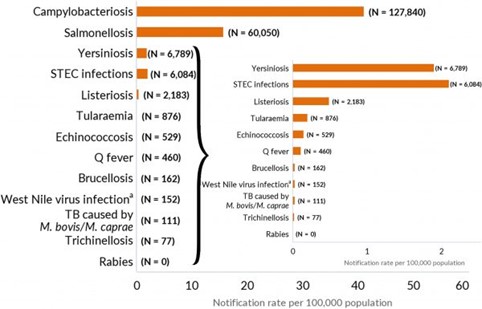
Campylobacter and Human Health: A Retrospective Analysis
Understanding Campylobacter
The genus Campylobacter comprises small, curved or spiral-shaped, gram-negative bacilli, with a flagellum polar at one or both ends of the bacterium for corkscrew-like movement. These microaerophilic bacteria have oxidase activity and do not form spores, thriving best in low oxygen concentration environments.
Thermophilic species of Campylobacter can grow at temperatures between 37-42ºC, making them commonly found in animals, particularly birds, which have higher body temperatures than mammals.

Unveiling Pathogenic Campylobacter Species
Currently, the Campylobacter genus consists of 17 species and six subspecies. Among these, the most prevalent pathogenic bacteria in humans are Campylobacter jejuni and Campylobacter coli, with less frequent occurrences of C. lari, C. upsaliensis, and C. fetus.
The virulence factors that enable Campylobacter to cause harm to host cells include flagella-mediated motility, adherence to the intestinal mucosa, invasiveness and inflammatory capacity, and toxin production. Gram-negative bacteria frequently produce the CDT toxin (cytolethal distension toxin), which, through its DNase activity, inhibits cell mitosis and ultimately leads to cell death.
Campylobacter's Human Infection Pathways
Campylobacter species are commonly found in the intestines of both healthy wild and domestic animals, including poultry, cattle, pigs, sheep, dogs, and cats. As a result, campylobacteriosis is considered a zoonosis – a disease transmitted to humans through animals or animal products that may be contaminated by feces. Contaminated water, often due to fecal contamination, can also serve as a source of infection.
Disease Dynamics and Treatment
Campylobacteriosis manifests with symptoms such as diarrhea (often with blood), fever, and abdominal pain. In rare cases, the infection can lead to severe complications, including sepsis, reactive arthritis, or neurological disorders like Guillain-Barré syndrome.
Generally, treatment involves fluid and electrolyte replacement, with antimicrobial therapy recommended for invasive cases or to suppress the carrier state.

Emerging Antibiotic Resistance
Antibiotic resistance in Campylobacter is an emerging global problem and has been recognised by the World Health Organization (WHO) as a serious public health concern. Most Campylobacter strains exhibit resistance to antibiotics such as fluoroquinolones, tetracycline, and erythromycin, although resistance patterns may vary between strains and geographic regions. The indiscriminate use of antibiotics in animal production for several decades to control, prevent, and treat infections and enhance animal growth is the primary cause of this resistance.
Regulatory Measures and Incidence of Campylobacter
Within the EU, campylobacteriosis is the most reported zoonotic disease, with over 246,000 human cases annually according to the latest report by the European Food Safety Agency (EFSA). Fortunately, the mortality rate remains low at 0.03%. Chicken meat (37.5%) and turkey meat (28.2%) represent the highest incidence of contamination.

In recent years, there has been a significant increase in Campylobacter monitoring and control plans on poultry farms, especially in the fattening chicken sector. These measures include the implementation of biosecurity measures, regular testing of poultry for Campylobacter, and the adoption of proper handling practices during production and processing to minimize meat contamination.

Furthermore, regulatory agencies emphasize consumer awareness campaigns, which provide information on safe handling of raw food, thorough cooking, and good kitchen hygiene to prevent or reduce the risk posed by these contaminated foods.
The reference method for detecting and enumerating Campylobacter spp. in food samples is ISO 10272. At Lab Unlimited, a trusted supplier of Condalab products, you can find a comprehensive range of solutions for your analysis needs. Visit our website to explore our products, and don't miss our CondalabTalk on "Campylobacter and its impact on human health."
As a trusted supplier of Condalab products, Lab Unlimited provides cutting-edge tools for your microbiological needs. Discover a comprehensive range of cultivation, identification, and analysis products.
|
To Find Out More: |
